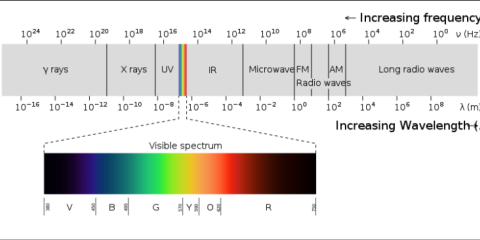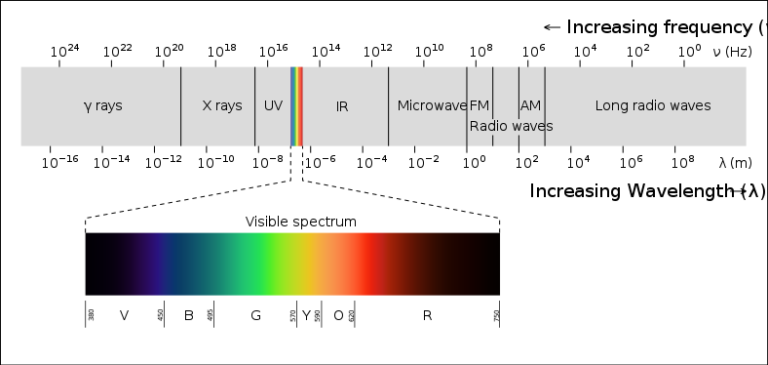(Hyper)spectral Imaging

(Hyper)spectral Imaging
The human eye can absorb 3 different wavelengths λ of light in the visible spectrum within 380 to 750 nanometers(nm). The signal is then processed by the brain which enables the human to see colors.

The electromagnetic spectrum (by Philip Ronan, CC BY-SA 3.0, via Wikimedia Commons)
But there is also a high range of light the human eye cannot see, but that contains information about the environment. For example, bees can also perceive UV light, which has shorter wavelengths than the human’s visible spectrum to find the flower opening. And Infrared light, which has higher wavelengths, could be used for night vision or thermal imaging.
In hyperspectral imaging, a large number of wavelengths are recorded. These bands typically span the visible spectrum (VIS) and the near-infrared range (NIR), some sensors also have bands in the short-wavelength infrared (SWIR), mid-wavelength infrared (MIR) or thermal infrared (TIR). From the recorded reflection characteristics, spectral signatures can be created, that could be used as unique fingerprints to distinguish between materials.

Different spectral samplings: RGB, Multispectral, Hyperspectral (by Lucasbosch, CC BY-SA 4.0, via Wikimedia Commons)
Applications
The ability to distinguish between materials i.e. their chemical composition could be used in various fields. It is often used in remote sensing and geology: Identifying the composition of the ground is useful for mining (e.g. to identify certain minerals), but also for agriculture or for the analysis of our Earth’s vegetation to determine the number of plants and their health.
In medicine, multi- or hyperspectral imaging helps in diagnosis as well as in image-guided surgery showing information on tissue physiology, morphology, and composition, that is invisible to the human eye. Another application is Food quality inspection and general defect detection of materials
Image acquisition (sensors)
Hyperspectral cameras capture a set of images for different ranges λ of the electromagnetic spectrum, called a spectral band. Measuring those for each spatial position in a hyperspectral cube width × height × λ. There are multiple techniques to acquire hyperspectral data.
Multispectral acquisition techniques by Lucasbosch CC BY-SA 4.0, via Wikimedia Commons
- Spatial scanning cameras scan only lines or points and use a prism or a grating to disperse the different wavelengths on the camera sensor. Each point or line is, therefore, scanned sequentially. This requires a static scene and precise mechanics for moving the camera.
- Spectral scanning cameras scan multiple monochromatic images each of a different wavelength, therefore band-pass filters are used that allow only certain wavelengths to pass. To create a multispectral image multiple images are taken where in between the filter is changed. This also requires a static scene. But allows using specific bands that are interesting for the application.
- Snapshot hyperspectral imaging allows to directly record the datacube without any scanning techniques but requires sometimes extensive interpolation which can introduce artifacts.